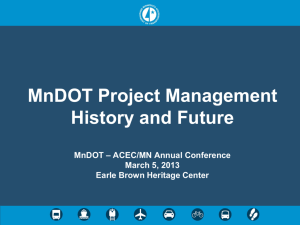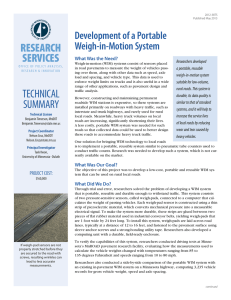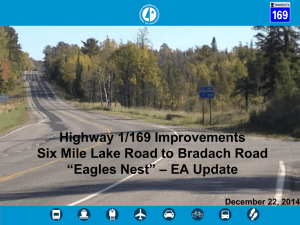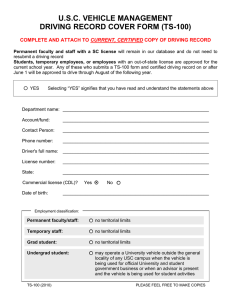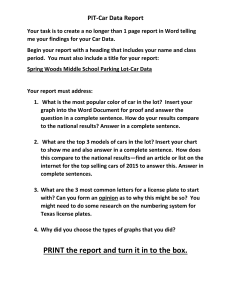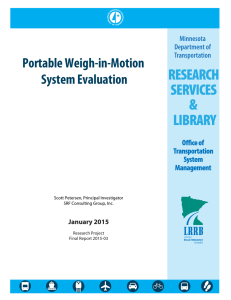RESEARCH SERVICES & LIBRARY Improving Vehicle Classification at
advertisement
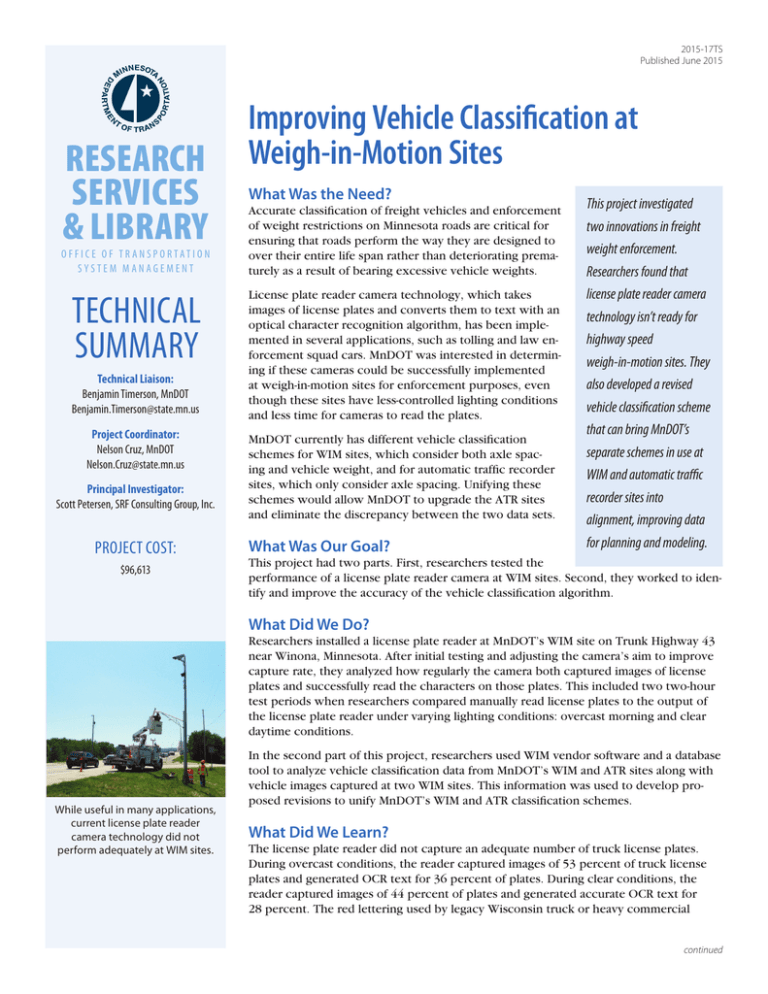
2015-17TS Published June 2015 RESEARCH SERVICES & LIBRARY O FFICE O F TR ANSP O R TATI O N SYSTEM MANAGEMENT TECHNICAL SUMMARY Technical Liaison: Benjamin Timerson, MnDOT Benjamin.Timerson@state.mn.us Project Coordinator: Nelson Cruz, MnDOT Nelson.Cruz@state.mn.us Principal Investigator: Scott Petersen, SRF Consulting Group, Inc. PROJECT COST: $96,613 Improving Vehicle Classification at Weigh-in-Motion Sites What Was the Need? Accurate classification of freight vehicles and enforcement of weight restrictions on Minnesota roads are critical for ensuring that roads perform the way they are designed to over their entire life span rather than deteriorating prematurely as a result of bearing excessive vehicle weights. License plate reader camera technology, which takes images of license plates and converts them to text with an optical character recognition algorithm, has been implemented in several applications, such as tolling and law enforcement squad cars. MnDOT was interested in determining if these cameras could be successfully implemented at weigh-in-motion sites for enforcement purposes, even though these sites have less-controlled lighting conditions and less time for cameras to read the plates. MnDOT currently has different vehicle classification schemes for WIM sites, which consider both axle spacing and vehicle weight, and for automatic traffic recorder sites, which only consider axle spacing. Unifying these schemes would allow MnDOT to upgrade the ATR sites and eliminate the discrepancy between the two data sets. What Was Our Goal? This project investigated two innovations in freight weight enforcement. Researchers found that license plate reader camera technology isn’t ready for highway speed weigh-in-motion sites. They also developed a revised vehicle classification scheme that can bring MnDOT’s separate schemes in use at WIM and automatic traffic recorder sites into alignment, improving data for planning and modeling. This project had two parts. First, researchers tested the performance of a license plate reader camera at WIM sites. Second, they worked to identify and improve the accuracy of the vehicle classification algorithm. What Did We Do? Researchers installed a license plate reader at MnDOT’s WIM site on Trunk Highway 43 near Winona, Minnesota. After initial testing and adjusting the camera’s aim to improve capture rate, they analyzed how regularly the camera both captured images of license plates and successfully read the characters on those plates. This included two two-hour test periods when researchers compared manually read license plates to the output of the license plate reader under varying lighting conditions: overcast morning and clear daytime conditions. While useful in many applications, current license plate reader camera technology did not perform adequately at WIM sites. In the second part of this project, researchers used WIM vendor software and a database tool to analyze vehicle classification data from MnDOT’s WIM and ATR sites along with vehicle images captured at two WIM sites. This information was used to develop proposed revisions to unify MnDOT’s WIM and ATR classification schemes. What Did We Learn? The license plate reader did not capture an adequate number of truck license plates. During overcast conditions, the reader captured images of 53 percent of truck license plates and generated OCR text for 36 percent of plates. During clear conditions, the reader captured images of 44 percent of plates and generated accurate OCR text for 28 percent. The red lettering used by legacy Wisconsin truck or heavy commercial continued “While the WIM classification scheme offers additional weight data over axle-spacing-based schemes, MnDOT has put years of work into revising its ATR scheme. This project worked to unify the systems and bring the WIM classification scheme in line with the ATR scheme.” Researchers matched images collected by overview cameras at WIM sites with vehicle records collected by sensors at those sites to provide insight into potential refinements to the WIM classification system. —Scott Petersen, Associate, SRF Consulting Group, Inc. “We don’t want to compare apples and oranges in our classification schemes. We want to compare different types of apples. We have updated some ATR sites to become WIM sites, and we don’t want their classification data to look totally different.” —Benjamin Timerson, Transportation Data and Analysis Program Manager, MnDOT Office of Transportation System Management Produced by CTC & Associates for: Minnesota Department of Transportation Research Services & Library MS 330, First Floor 395 John Ireland Blvd. St. Paul, MN 55155-1899 651-366-3780 www.mndot.gov/research plates proved particularly difficult for the camera to read. The nighttime test was halted because of a lack of trucks and because oncoming headlights made it very difficult for either the license plate reader or the manual observers to discern plates. Since MnDOT’s ATR classification scheme generally produces acceptable results, the project primarily adjusted the WIM classification scheme to make it more compatible with the ATR scheme. Revisions to the WIM classification scheme eliminated some overlaps where vehicles could be placed in more than one classification. What’s Next? Given the poor performance of the license plate reader, the Minnesota State Patrol has indicated it has no plans to implement the system at its current level of technology in environments such as high-speed WIM sites that have inconsistent lighting and high travel speeds. While no classification scheme based on axle spacing and/or weights will perfectly classify all vehicles, the revised scheme has been verified with anecdotal checks against WIM records with images. MnDOT will continue monitoring the scheme to see how well it classifies vehicles. Of particular interest will be the system’s ability to classify new vehicle types such as concrete or dairy trucks that can have varying numbers of axles depending on whether they are empty or full. Improved vehicle classifications will be valuable for ensuring that when roads are redesigned, these new designs reflect their actual vehicle loading. This Technical Summary pertains to Report 2015-17, “Commercial Vehicle Enforcement Innovation,” published April 2015. The full report can be accessed at mndot.gov/research/TS/2015/201517.pdf.

